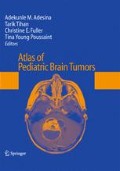Abstract
A group of glial tumors exhibiting ependymal differentiation including subependymoma (WHO grade I), myxopapillary ependymoma (WHO grade I), ependymoma (WHO grade II; variants including cellular, tanycytic, papillary, and clear cell), and anaplastic ependymoma (WHO grade III). Most are sporadic; ependymomas may be seen as part of neurofibromatosis type 2, a hereditary cancer predisposition syndrome with germline mutation of NF2/Merlin gene. Recent evidence supports radial glia as the candidate cell of origin for ependymomas; subependymomas appear to derive from subependymal glial precursors.
Access this chapter
Tax calculation will be finalised at checkout
Purchases are for personal use only
Suggested Reading
Dyer S, Prebble E, Davison V, Davies P, Ramani P, Ellison D, Grundy R (2002) Genomic imbalances in pediatric intracranial ependymomas define clinically relevant groups. Am J Pathol 161:2133–2141
Fassett DR, Pingree J, Kestle JR (2005) The high incidence of tumor dissemination in myxopapillary ependymoma in pediatric patients. Report of five cases and review of the literature. J Neurosurg 102:59–64
Figarella-Branger D, Civatte M, Bouvier-Labit C, Gouvernet J, Gambarelli D, Gentet J-C, Lena G, Choux M, Pellissier JF (2000) Prognostic factors in intracranial ependymomas in children. J Neurosurg 93:605–613
Fouladi M, Helton K, Dalton J, Gilger E, Gajjar A, Merchant T, Kun L, Newsham IF, Burger PC, Fuller CE (2003) Clear cell ependymoma: a clinicopathologic and radiographic analysis of 10 patients. Cancer 98:2232–2244
Grill J, Avet-Loiseau H, Lellouch-Tubiana A, Sevenet N, Terrier-Lacombe M-J, Venaut A-M, Doz F, Sainte-Rose C, Kalifa C, Vassal G (2002) Comparative genomic hybridization detects specific cytogenetic abnormalities in pediatric ependymomas and choroid plexus papillomas. Cancer Genet Cytogenet 136:121–125
Kramer DL, Parmiter AH, Rorke LB, Sutton LN, Biegel JA (1998) Molecular cytogenetic studies of pediatric ependymomas. J Neurooncol 37:25–33
Mendrzyk F, Korshunov A, Benner A, Toedt G, Pfister S, Radlwimmer B, Lichter P (2006) Identification of gains on 1q and epidermal growth factor receptor overexpression as independent prognostic markers in intracranial ependymoma. Clin Cancer Res 12:2070–2079
Merchant TE, Jenkins JJ, Burger PC, Sanford RA, Sherwood SH, Jones-Wallace D, Heideman RL, Thompson SJ, Helton KJ, Kun LE (2002) Influence of tumor grade on time to progression after irradiation for localized ependymoma in children. Int J Radiat Oncol Biol Phys 53:52–57
Perilongo G, Massimino M, Sotti G, Belfontali T, Masiero L, Rigobello L, Garre L, Carli M, Lombardi F, Solero C, Sainati L, Canale V, del Prever AB, Giangaspero F, Andreussi L, Mazza C, Madon E (1997) Analyses of prognostic factors in a retrospective review of 92 children with ependymoma: Italian Pediatric Neuro-Oncology Group. Med Pediatr Oncol 29:79–85
Reardon DA, Entrekin RE, Sublett J, Ragsdale S, Li H, Boyett J, Kepner JL, Look T (1999) Chromosome arm 6q loss is the most common recurrent autosomal alteration detected in primary pediatric ependymoma. Genes Chromosomes Cancer 24:230–237
Shu HK, Sall WF, Maity A, Tochner ZA, Janss AJ, Belasco JB, Rorke-Adams LB, Phillips PC, Sutton LN, Fisher MJ (2007) Childhood intracranial ependymoma: twenty-year experience from a single institution. Cancer 110:432–441
Snuderl M, Chi SN, De Santis SM, Stemmer-Rachamimov AO, Betensky RA, De Girolami U, Kieran MW (2008) Prognostic value of tumor microinvasion and metalloproteinases expression in intracranial pediatric ependymomas. J Neuropathol Exp Neurol 67:911–920
Taylor MD, Poppleton H, Fuller CE, Su X, Liu Y, Jensen P, Magdaleno S, Dalton J, Calabrese C, Board J, Macdonald T, Rutka J, Guha A, Gajjar A, Curran T, Gilbertson R (2005) Radial glia cells are candidate stem cells of ependymoma. Cancer Cell 8:323–335
Tihan T, Zhou T, Holmes E, Burger PC, Ozuysal S, Rushing EJ (2008) The prognostic value of histological grading of posterior fossa ependymomas in children: a Children’s Oncology Group study and a review of prognostic factors. Mod Pathol 21:165–177
Ward S, Harding B, Wilkins P, Harkness W, Hayward R, Darling JL, Thomas DGT, Warr T (2001) Gain of 1q and loss of 22 are the most common changes detected by comparative genomic hybridization in paediatric ependymoma. Genes Chromosomes Cancer 32:59–66
Zamecnik J, Snuderl M, Eckschlager T, Chanova M, Hladikova M, Tichy M, Kodet R (2003) Pediatric intracranial ependymomas: prognostic relevance of histological, immunohistochemical, and flow cytometric factors. Mod Pathol 16:980–991
Author information
Authors and Affiliations
Editor information
Editors and Affiliations
Rights and permissions
Copyright information
© 2010 Springer Science+Business Media, LLC
About this chapter
Cite this chapter
Fuller, C.E., Narendra, S., Tolicica, I. (2010). Ependymal Tumors. In: Adesina, A., Tihan, T., Fuller, C., Poussaint, T. (eds) Atlas of Pediatric Brain Tumors. Springer, New York, NY. https://doi.org/10.1007/978-1-4419-1062-2_5
Download citation
DOI: https://doi.org/10.1007/978-1-4419-1062-2_5
Published:
Publisher Name: Springer, New York, NY
Print ISBN: 978-1-4419-1061-5
Online ISBN: 978-1-4419-1062-2
eBook Packages: MedicineMedicine (R0)

